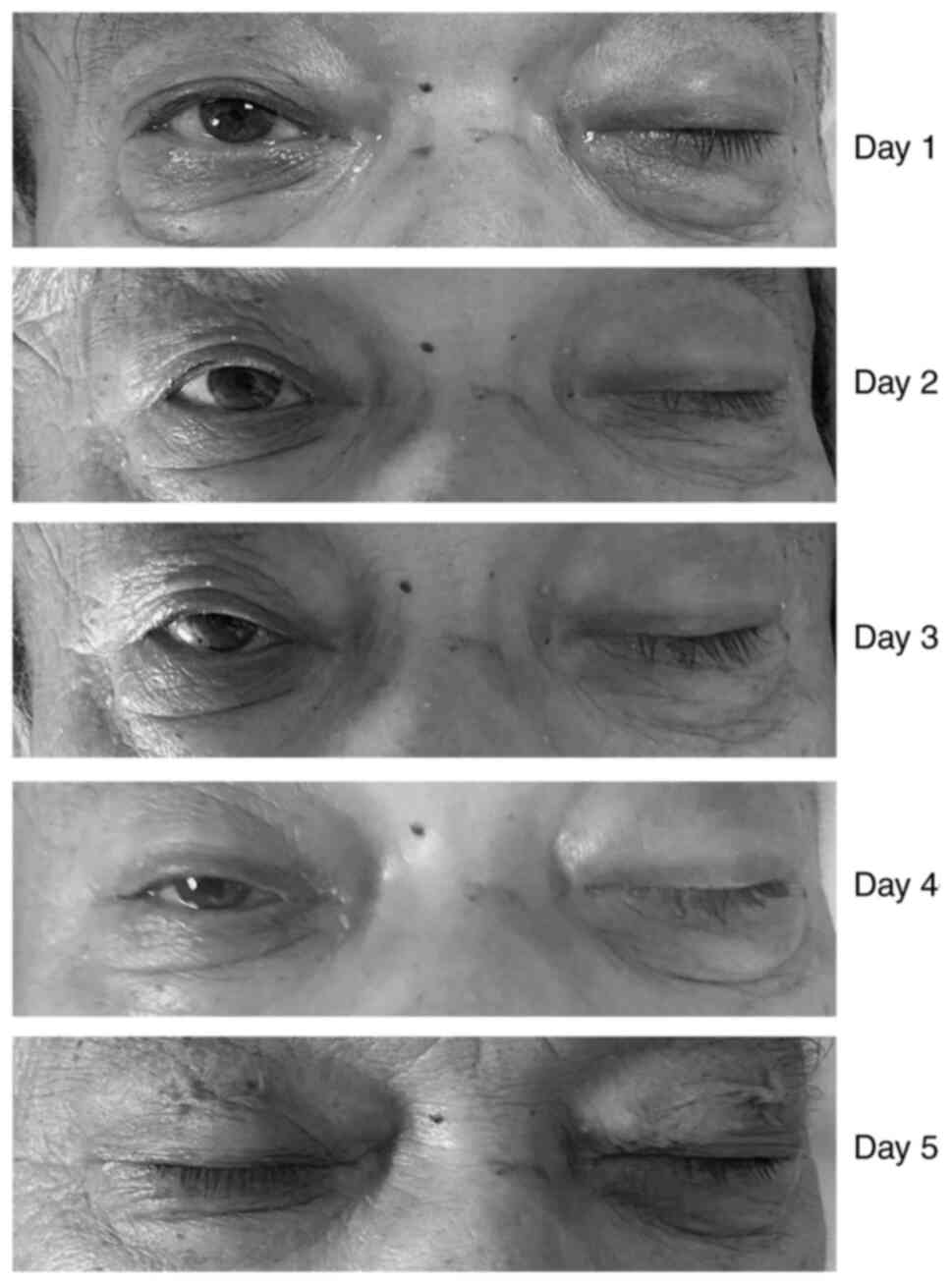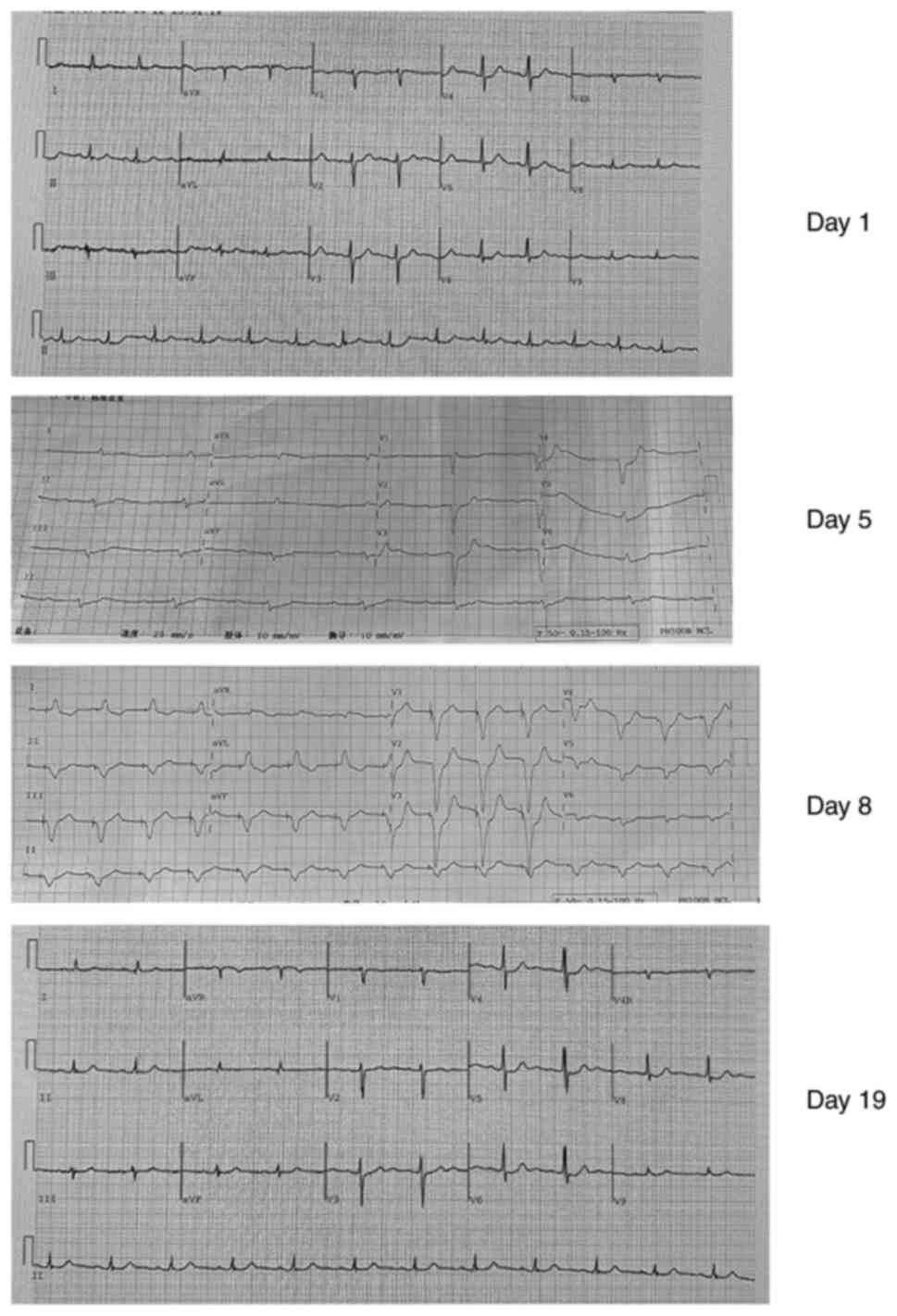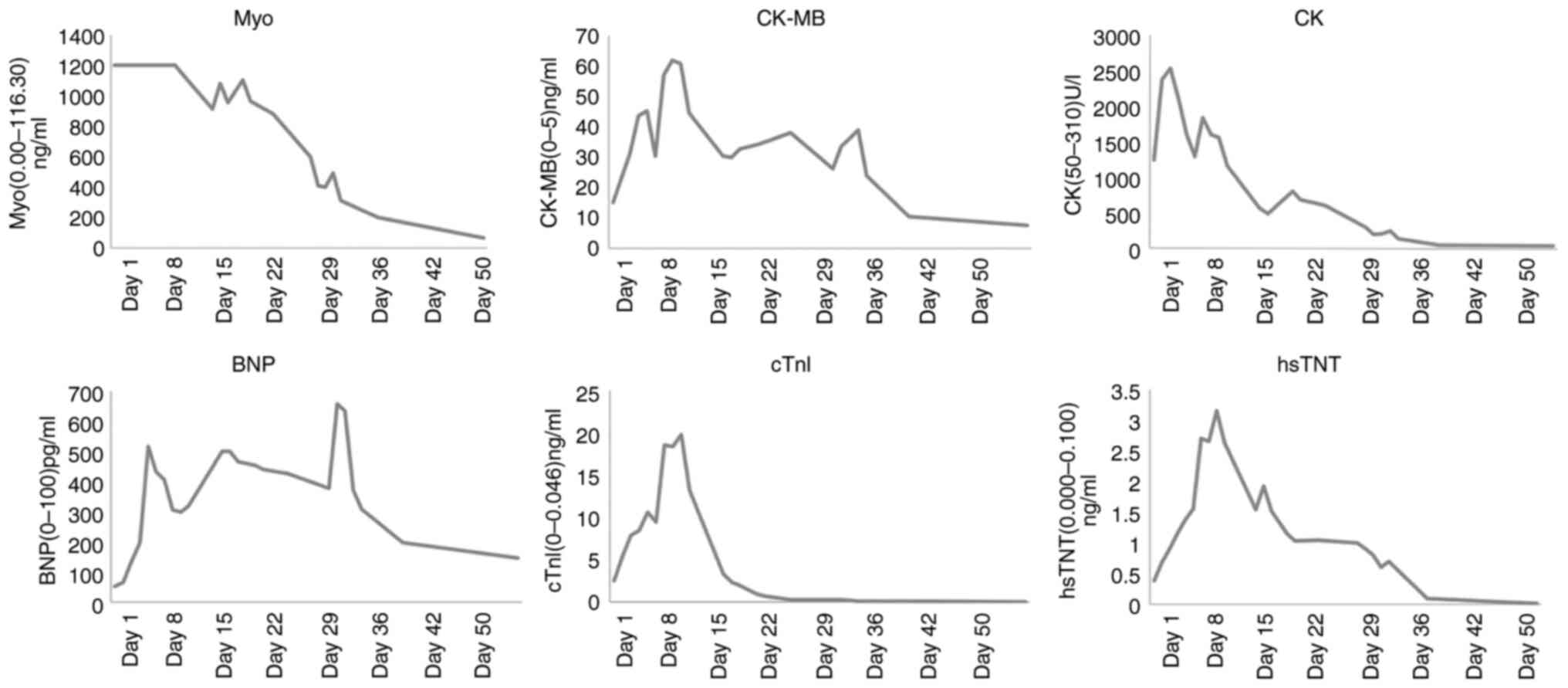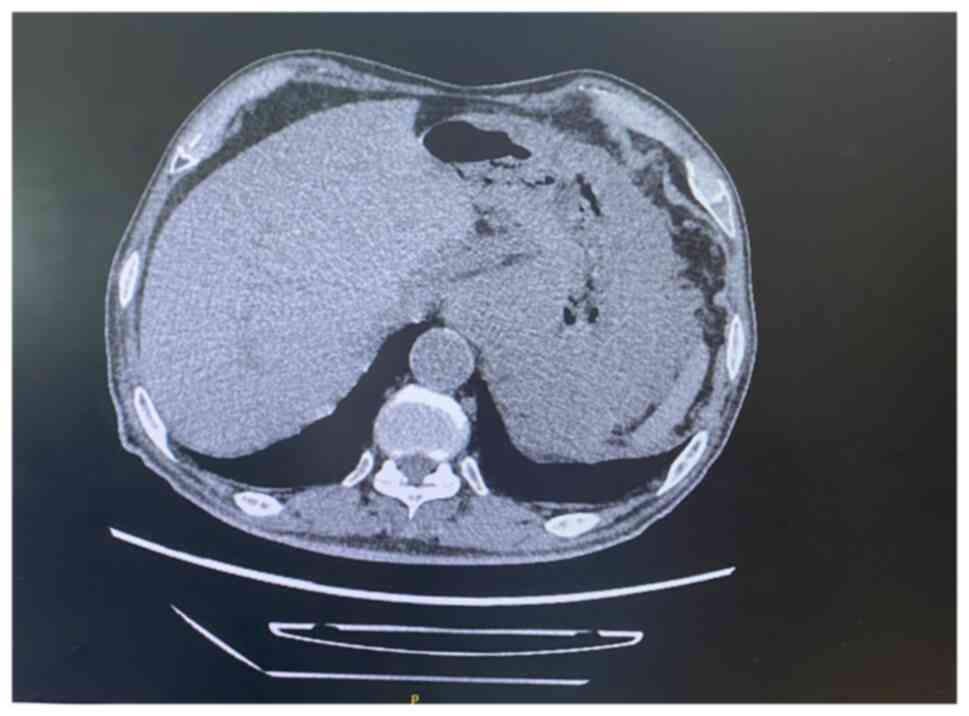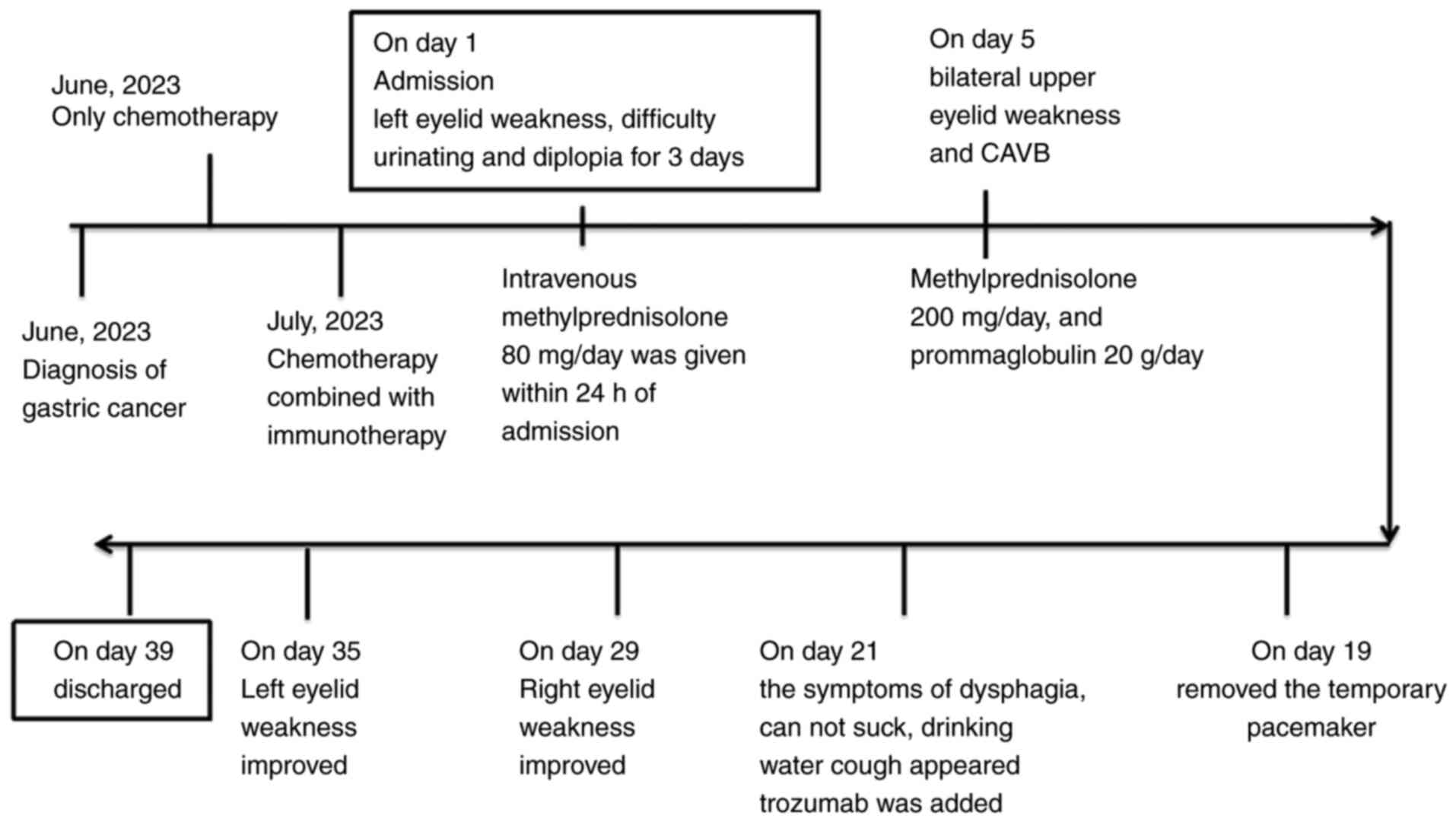Myasthenia gravis and myocarditis induced by chemoimmunotherapy in locally advanced gastric cancer: A case report
- Authors:
- Published online on: September 11, 2024 https://doi.org/10.3892/etm.2024.12715
- Article Number: 426
-
Copyright: © Wang et al. This is an open access article distributed under the terms of Creative Commons Attribution License.
Abstract
Introduction
Sintilimab, as a type of immune checkpoint inhibitor (ICI), represents a notable advancement in the treatment of gastric cancers. It is a fully recombinant human anti-PD1 IgG4 monoclonal antibody (1). The adverse events associated with the use of sintilimab include pneumonitis, hepatitis and endocrinopathies, as well as myocarditis (2). Despite exhibiting notable treatment efficacy, this type of agent may be associated with life-threatening immune-related adverse events (3). Myocarditis together with myositis or myasthenia gravis overlap syndrome (IM3OS) is one such event. Although the majority of cases of myocarditis associated with ICI occur in isolation, 30-40% of cases occur together with myasthenia gravis and/or myositis (4,5). However, the treatment, clinical presentation and outcomes remain unclear (2).
IM3OS can be associated with significant mortality and morbidity (2). Myocarditis induced by ICI is a life-threatening complication, with mortality rates ranging from 25 to 50% (5,6). In order to describe patient clinical features and characteristics, including biomarker and laboratory data, some authors have published individual reports, and some authors have published case series of patients with ICI-related overlap syndrome (7,8). However, to date, to the best of our knowledge, there have been no reported cases of patients with gastric cancer with myasthenia gravis and myocarditis induced by chemoimmunotherapy, who have survived, and which also detail symptom evolution, the treatment history and changes in laboratory indices. The present study reports the case of patient with gastric cancer case with myasthenia gravis and myocarditis induced by chemoimmunotherapy, who survived.
In addition, the management strategies of IM3OS induced by chemoimmunotherapy are full of challenges. Most strategies are focused on the treatment of extensive cancer, and do not depend on the cancer species. The majority of strategies provide a treatment strategyfor a single symptom; however, they do not provide for an overlap of symptoms, including myasthenia gravis and myocarditis (9,10). Therefore, the clinical treatment of the present patient was challenging. It is hoped that through our case, similar patients can be provided a reference.
Case report
A 72-year-old male patient with no history of autoimmune diseases was admitted to the First Hospital of China Medical University (Shenyang, China) in June 2023 due to weakness of the gastric wall of the cardia, gastric fundus and gastric body, rough serosa, uneven enhancement on an enhanced scan, a local mass protruding into the cavity and enhanced nodules around the stomach. The greater omentum was slightly thickened, the density was increased, and the mass could be seen as a locally diffuse space-occupying lesion in the stomach; the involvement of the adjacent greater omentum seemed likely; thus, a clinical and microscopic examination was performed in combination. A gallstone was found as a localized fatty infiltration in the head of the pancreas. A bilateral renal cyst was also found, evidenced by left renal local cortical atrophy. The patient was also found to have benign prostatic hyperplasia and abdominal and pelvic effusion. Multiple retroperitoneal lymph nodes were found. The patient had no conditions that would prevent the use of chemotherapy, and was administered one cycle of chemotherapy with SOX regimen in June 2023, including oxaliplatin at 180 mg D1 intravenous drip and Tigio at 60 mgd1-d14 twice a day, once every 3 weeks. The results of gene detection analysis of the patient suggested that microsatellite stability, tumor cell proportion score=5% and combined positive score=40. For the results of gene detection, the patient was treated with the SOX regimen combined with sintilimab in the second cycle from July 2023. Specifically, this cycle included: Oxaliplatin 180 mg D1 via intravenous drip, Tigio at 60 mg d1-d14 was taken orally twice a day and 200 mg sintilimab (one type of ICI which was widely used in China) was administered intravenously every 3 weeks. At the same time, symptomatic and supportive treatments, such as antiemetic drugs and drugs for stomach protection were initiated.
Initially, almost no adverse events occurred in the first cycle of treatment [chemotherapy:oxaliplatin combine S1(Tigio)], and the patient developed fatigue G1 as a single adverse event after the first cycle of treatment with chemoimmunotherapy (oxaliplatin + Tigio + sintilimab). However, 3 days prior to admission for the second cycle of chemoimmunotherapy, the patient developed left eyelid weakness, difficulty urinating and diplopia (Fig. 1). Following admission (August 2023), the patient was evaluated according to the Lovett muscle strength scale (11). The muscle strength of the patient's four limbs was grade V. An electrocardiogram revealed sinus tachycardia (atrial rate 80 beats/min), complete right bundle branch block, ST change and left axis deviation (Fig. 2). The patient had no dyspnea and dysphagia, had an occasional mild shortness of breath and clear articulation; his recent dietary status and sleep quality were sufficient, he had no obvious black stool and no significant change in body weight. Following admission, an indwelling catheter was inserted, and related laboratory and imaging examinations were performed at the same time. The results revealed of these tests are presented in Table I and Fig. 3. The level of creatinine kinase isoenzyme was 15.03 ng/ml, B-type brain sodium peptide was 52 pg/ml, creatinine kinase was 1,244 U/l, high sensitivity-Troponin T was 0.379 ng/l, cardiac troponin I was 2.460 ng/ml, lactate dehydrogenase was 487 U/l and myoglobin was >1,200 ng/ml. The curative effect was evaluated as stable disease (Fig. 4).
The changes in clinical manifestations and treatment following admission are as presented in Fig. 5. Upon admission (August 2023), considering the clinical symptoms, laboratory indicators and imaging examination results, the patient was diagnosed with immune-associated myocarditis combined with myasthenia gravis. The ICIs were discontinued upon admission, and intravenous methylprednisolone at 80 mg/day, acid suppression and myocardial protection therapy were administered within 24 h of admission. At 1 day following admission, the left eyelid weakness progressively worsened; in addition, the patient experienced difficulty in lifting the other eyelid (Fig. 1). At 2 days following admission, the diplopia continued and eyelid weakness became more severe; therefore, the methylprednisolone dose was increased to 200 mg/day, and gammaglobulin at 20 g/day was added; the patient then experienced difficulty in speaking and complete atrioventricular block (CAVB) on day 5 after admission (Fig. 2). As the patient also experienced heart rate fluctuations between 30 and 40 beats/min, a temporary transvenous pacemaker was inserted.
A coronary computed tomographic angiography scan revealed no significant coronary artery stenosis. The intraoperative physician considered that the patient had significant myocardial edema. On day 10, the serum creatine kinase and troponin I level steadily decreased. On day 14, the patient was administered an intravenous injection of 80 mg methylprednisolone sodium succinate, and the gammaglobulin dose was reduced to 20 g/day. On day 19 (2 weeks following the symptom of CAVB), an electrocardiogram revealed an improvement in atrioventricular conduction (as shown in Fig. 2), and the temporary pacemaker was removed. On day 20, the patient exhibited symptoms of dysphagia, was unable to suck and coughed when drinking water. On day 21, the patient was treated with trozumab (80 mg/day). On day 22, an attempt to pull out the catheter failed. Gammaglobulin and methylprednisolone treatment was continued on days 25-29. From days 30-31, the symptoms of right eyelid weakness and inarticulation improved, while the symptoms of dysphagia and an occasional episode of coughing persisted. The myocardial index had also improved. The dose of gammaglobulin was adjusted to 5 g/day, and methylprednisolone was continued at 80 mg/day; at the same time, the respiratory function was exercised. On day 32 the dysphagia was attenuated. The right eyelid movement began to improve and the patient was able to slightly open his right eye. On day 35, the patient was able to half-open his right eyelid and could slightly open his left eyelid. Liquid food and intravenous nutrition were provided. The dose of piperacillin tazobactam sodium was adjusted to 4.5 b.i.d. The urinary catheter was also successfully removed. On day 36, there was an improvement in all symptoms, and the dose of methylprednisolone was changed to 40 mg/day orally. On day 39, the patient was discharged. After 1 month, the levels of myocardial enzyme indices decreased to normal levels (Table I and Fig. 3). After a period of 2 months (in October, 2023), the patient returned to the hospital for conventional chemotherapy, and, to date, at follow-up, there has been no recurrence of previous symptoms.
Discussion
In recent years, ICIs have become a novel therapy for advanced-stage tumors (12). Sintilimab, a type of ICI, is widely used in China, and was previously extensively used for the treatment of lung cancer or malignant melanoma for ~2 years before it was used for the treatment of gastric cancer. Pneumonitis, endocrinopathies, hepatitis, gastrointestinal toxicity, myositis and dermatological toxicity are common side-effects associated with its use (13). In recent years, cardiovascular toxicity, as a rare immune related adverse event, has been commonly reported (5,14). The fatality rate is as high as 67% with combination immunotherapy and as high as 50% with monotherapy; however, the incidence of myocarditis induced by immune therapy ranges only from 0.09 to 1.14% (5).
It has been widely studied in numerous types of cancer, including gastric cancer (15). However, patients with gastric cancer presenting with immuno-related ocular type myasthenia gravis and myocarditis, without limp weakness, without severe dyspnea, but combined with urination difficulties and symptoms of third-degree atrioventricular block, have not been previously reported to the best of our knowledge. ICI-related myocarditis has been mostly reported in patients with melanoma and lung cancer (5). Likewise, patients with lung cancer, melanoma, or other types of cancer are the ones who most commonly experience immune-related myasthenia gravis (16). This suggests no differences in the incidence of ICI-related adverse events by cancer type (17). However, patients with unresectable primary lesions or positive fecal occult blood are at a high risk of developing gastrointestinal bleeding. Notably, there is no consensus yet available on whether hormones can be used for such patients, or the dose to be used, or the duration of medication and points for attention during the course of treatment; these issues have not been previously reported or studied and an established theory on this matter is still lacking.
The present case presented is, to the best of our knowledge, the first reported case of a patient with locally advanced gastric cancer who developed immune-related myasthenia gravis and myocarditis and survived. The patient was treated with sintilimab together with chemotherapy with the written consent of himself and his family. The patient was admitted to hospital due to left eyelid weakness, difficulty urinating and diplopia at 19 days following only one cycle of chemoimmunotherapy. The initial symptoms were dysuria and weakness of the left eyelid, and the clinical manifestations progressed rapidly at 1 week following admission. A third-degree atrioventricular block occurred on 5th day following admission; a pacemaker was thus inserted and this pacemaker was removed on the 19th day. Coronary computed tomographic angiography revealed no significant coronary artery stenosis. Methylprednisolone was administered upon admission; however, treatment the effect was not satisfactory, and the symptoms continued progress. Gammaglobulin was added to the treatment regimen on the 3rd day following admission. Following the use of gammaglobulin, eyelid weakness and dysuria did not improve; however, there was an improvement in the third-degree atrioventricular block and the pacemaker was thus successfully removed. For the symptoms of dysphagia, inability to suck and coughing when drinking water, trozumab was added to the treatment regimen on day 21. The symptoms improved on the 29th day and the catheter was removed on the 35th day. The diagnosis of ICI-induced myasthenia gravis and myocarditis reached following careful consideration. For example, primary myasthenia and fatal emergencies, such as acute and aortic dissection were excluded. Subsequently, diseases that cause oculomotor nerve palsy were also excluded. Considering the onset time of eyelid weakness, and the time of sintilimab usage, ICI-associated myasthenia gravis was highly suspected. Unfortunately, indicators of negative/positive acetylcholine receptor antibody and EMG results were not available for the patient. Subsequently, considering that the coronary computed tomographic angiography revealed no significant coronary artery stenosis, third-degree atrioventricular block caused by acute myocardial infarction was excluded. The patient did not express chest pain and gasping; thus, acute pulmonary embolism and aortic dissection were excluded. The symptoms of the patient and the examination results did not support these emergencies.
Immuno-induced myasthenia gravis combined with myocarditis is a rare, yet critical disease. It is often overlooked due to tumor-related symptoms. Thus, it is even more critical to identify the predictive factors and provide early treatment for patients. The increase in myoglobin levels may be a good predictive factor. In the in the present study (Table I and Fig. 3), myoglobin levels reached peak levels much earlier than other myocardial enzyme indicators and clinical symptoms. The authors searched all similar cases on PubMed; however, no studies reporting patterns of myoglobin and several other myocardial enzymes were identified. To the best of our knowledge, only three reports have mentioned specific myocardial enzyme indices. For example, Gao et al (18) reported a patient with hs-cTnT 3,015 pg/ml, NT-proBNP 5,671 pg/ml and CK 1,419 U/l, whose main symptoms were chest tightness, shortness of breath and the progressive aggravation of limb weakness. Kondo et al (19) reported two cases of ICI-induced myocarditis with CAVB with different clinical outcomes. In the first case, who finally succumbed, the complete atrioventricular block did not improve. By contrast, in the second case, who survived, intravenous mPSL pulse therapy at 1,000 mg/day was used within 24 h and the level of troponin I decreased rapidly. Wang et al (20) presented a report that the level of cTnI was 13.5767 ng/ml, that of α-HBD was 1,104.93 U/l and the pro-BNP level was 2,164.4 pg/ml. Following plasmapheresis, the level of cTnI decreased to 10.4138 ng/ml and that of pro-BNP decreased to 910.4 pg/ml. After 1 day, the cTnI level increased to 18.0849 ng/ml and that of pro-BNP rapidly increased to 1,227.1 pg/ml. That patient also finally succumbed. However, the aforementioned three studies did not point out the changing trend in myoglobin and its predictability. During the monitoring process of clinical immunotherapy, the myoglobin index may be improved, thus requiring testing only once a week. The earlier application of hormones may achieve better efficacy.
The elucidation of the mechanisms of myasthenia gravis combined with myocarditis induced by ICIs is the key for clinical treatment. However, the mechanisms involved are currently unclear. Some possible mechanisms have been previously mentioned, the first one being that cardiac myocytes may share the same targeted antigens with tumor cells (1,3). The second is that ICI-induced myocarditis may be identical to lymphocytic myocarditis (21). Third, some of the reported cases containing EMB have revealed that PD1+, CD8+ and granzyme B+ T-lymphocytes constitute the main lymphocytic infiltration (22,23). Fourth, mouse models have revealed that the peripheral immune tolerance may be broken by the blockade or absence of the PD1or PDL1 axis (1,24). These findings are consistent with those of patients with an injured myocardium (24). As is commonly known, ICIs weaken immune tolerance and enhance the release of specific T-cells from tumors, thus leading to heart tissue damage and activation (1,25). It is worth noting that Weaver et al (26) demonstrated that an overlap syndrome of myositis, myocarditis and myasthenia represents the most common presentation; when one of these symptoms occurs, the other two symptoms should also be paid more attention. Recently, the authors reviewed The Christie Hospital (Manchester, UK) database of immunotherapy-related toxicity from 2017 to 2020 and 10 patients with ICI-related MG were identified (26). In their cohort, they demonstrated good outcomes associated with early intensive immunosuppressive treatment with IVIG and IVMP. An agreed national treatment protocol or clinical discussion forum would be beneficial. However, the arrhythmia was not mentioned in their study. The relationship between arrhythmia and the aforementioned overlap syndrome is not clear, which may need further attention.
In order to combat the adverse effects induced by ICIs, immunosuppressive therapy is the key treatment (14). The two commonly used management strategies are the NCCN Clinical Practice Guidelines in Oncology, Management of Immunotherapy-Related Toxicity (9) and the Chinese Society of Clinical Oncology immune checkpoint inhibitor related toxicity management guidelines (10). However, both guidelines indicate that: Immediately after the diagnosis of immune-related side effects, 1 to 2 mg/kg/day of methylprednisolone should be administered for hemodynamically stable patients. For patients with myocarditis of grade 3 to 4, particularly those with fulminant malignant arrhythmia or myocarditis, intravenous methylprednisolone at 1,000 mg/day should be administered and maintained for 3 to 5 days (9,10,14,23).
Nguyen et al (27) reported a patient who was successfully treated using 1,000 mg/day methylprednisolone form the beginning. Liang et al (25) also reported a patient treated with 160 mg/q8 h methylprednisolone for 5 days. If patients do not respond well to hormone shock, tacrolimus, azathioprine, methotrexate and mycophenolate mofetil may be used as immunomodulatory chemical drugs; infliximab, rituximab, ruxolitinib, abatacept and tocilizumab may be used as biological agents; and antithymocyte globulin as immunoglobulin (9,10,14,21). Moreover, lymphocyte depletion, plasmapheresis and ECLS could also be proposed (21). The common hemodynamic and respiratory support treatment could also be employed at the same time (14).
However, the patients in the aforementioned studies mainly consisted of patients with renal cancer, melanoma, lung cancer and colorectal cancer, but not gastric cancer. Although these patients did not have gastric cancer, they are cancer patients who received immunochemotherapy before, and they incurred side effects caused by immunochemotherapy, including both of myocarditis and myasthenia gravis.
Komatsu et al (28) reported the first metastatic gastric cancer case of nivolumab-related myasthenia gravis and myocarditis; despite plasma exchange, methylprednisolone and immunoglobulin administration, the patient finally succumbed. When comparing the case in the present study with others, the patient was administered immunosuppressive therapy with methylprednisolone at 200 mg/day, gammaglobulin (20 g/day) and trozumab (80 mg/day). For hormone resistance, gammaglobulin total dosing should be 2 g/kg, administered in divided doses per package insert (11,23). Other immunosuppressive agents are also available such as Alemtuzumab, but the dosage is not mentioned (23).
Trozumab as an immunosuppressant, is recommended in the CSCO guidelines (24), but for the dosage is also not clear. Therefore, the present study used the clinical empirical safe dosage of gammaglobulin and tuzumab: Gammaglobulin (20 g/day) and trozumab (80 mg/day). Although these two doses are safe and within the scope of instructions, whether it is the most reasonable amount of immune-related toxicity therapy is still a question worth further study. Although this the present patient survived, it is not known which one of these three types of medicine was the key and considering that patients with gastric cancer have a higher risk of gastrointestinal bleeding compared with other tumors, intravenous methylprednisolone at 1,000 mg/day was not initiated. It remains unknown whether trozumab can be used in advance and the reasonable withdrawal time of hormones; it is hoped that there will be more research data to guide the treatment. Moreover, it continues to remain unclear whether tracing the medical history of patients, previous health conditions or regular exercise may prove useful, or whether long-term exercise is associated with increased immunity, whether there is any association between the lymphocyte count and the side-effects of ICIs. It is hoped that further research will shed light on this matter in the future.
There is a lack of clinical data on the long-term prognosis of such patients as they are often lost to follow-up or due to mortalities in the short term. Although, with the wide application of immunosuppressants, some researchers have reported a series of related side reactions. A single-center experience with systematic literature review and meta-analysis pointed out that most of the patients died in the short term due to critical illness (29). There is no prospective study to follow up such patients, and even the present case is the first reported case of a patient with locally advanced gastric cancer who developed immune-related myasthenia gravis and myocarditis and survived. Weaver et al (26) reported on 10 patients with ICI-related MG and myocarditis. Among the 10 patients, none of the patients died within 30 days of initial presentation. One patient died in the ICU at 6 months post initial presentation, while eight patients were still alive. Subsequently, one patient died from progressive cancer. At 12 months, a further four patients had died (2 due to progressive cancer, 1 due to sepsis and 1 due to aspiration pneumonia following relapsed myasthenia gravis). None of the patients were re-challenged with ICI therapy. However, unlike in the present study, none of these patients were noted to have cardiac arrhythmia.
In conclusion, the present study reports a rare case of patient with locally advanced gastric cancer who developed immuno-related myasthenia gravis and myocarditis, who survived. The present case report demonstrates the importance of improving the current understanding of ICI-induced myasthenia gravis with concomitant myocarditis following the administration of sintilimab in order to improve clinical outcomes. The predictive value of myoglobin in this disease warrants further research. There are a number of urgent problems to solve, such as the few management strategies for chemoimmunotherapy-induced myasthenia gravis and myocarditis in locally advanced gastric cancer and the long-term follow-up and care of such patients.
Acknowledgements
Not applicable.
Funding
Funding: No funding was received.
Availability of data and materials
The data generated in the present study may be requested from the corresponding author.
Authors' contributions
YuW, FL, YiW, QW and SD made substantial contributions to conception and design of the manuscript. XW and ZS contributed to acquisition and interpretation of data, and wrote the abstract. YuW and FL confirm the authenticity of all the raw data. All authors read and approved the final manuscript.
Ethics approval and consent to participate
Not applicable.
Patient consent for publication
The patient provided written informed consent for the publication of their data.
Competing interests
The authors declare that they have no competing interests.
References
|
Wang C, Zhong B, He J and Liao X: Immune checkpoint inhibitor sintilimab-induced lethal myocarditis overlapping with myasthenia gravis in thymoma patient: A case report. Medicine (Baltimore). 102(e33550)2023.PubMed/NCBI View Article : Google Scholar | |
|
Ye Z, Yang W, Xuan B, Li X, He J, Si H and Ma W: Efficacy and safety evaluation of sintilimab for cancer treatment: A systematic review and meta-analysis of randomized controlled trials. Front Pharmacol. 13(895187)2022.PubMed/NCBI View Article : Google Scholar | |
|
Pathak R, Katel A, Massarelli E, Villaflor VM, Sun V and Salgia R: Immune checkpoint inhibitor-induced myocarditis with myositis/myasthenia gravis overlap syndrome: A systematic review of cases. Oncologist. 26:1052–1061. 2021.PubMed/NCBI View Article : Google Scholar | |
|
Aldrich J, Pundole X, Tummala S, Palaskas N, Andersen CR, Shoukier M, Abdel-Wahab N, Deswal A and Suarez-Almazor ME: Inflammatory myositis in cancer patients receiving immune checkpoint inhibitors. Arthritis Rheumatol. 73:866–874. 2021.PubMed/NCBI View Article : Google Scholar | |
|
Moslehi JJ, Salem JE, Sosman JA, Lebrun-Vignes B and Johnson DB: Increased reporting of fatal immune checkpoint inhibitor-associated myocarditis. Lancet. 391(933)2018.PubMed/NCBI View Article : Google Scholar | |
|
Mahmood SS, Fradley MG, Cohen JV, Nohria A, Reynolds KL, Heinzerling LM, Sullivan RJ, Damrongwatanasuk R, Chen CL, Gupta D, et al: Myocarditis in patients treated with immune checkpoint inhibitors. J Am Coll Cardiol. 71:1755–1764. 2018.PubMed/NCBI View Article : Google Scholar | |
|
Kadowaki H, Akazawa H, Ishida J and Komuro I: Mechanisms and management of immune checkpoint inhibitor-related cardiac adverse events. JMA J. 4:91–98. 2021.PubMed/NCBI View Article : Google Scholar | |
|
Zhang L, Reynolds KL, Lyon AR, Palaskas N and Neilan TG: The evolving immunotherapy landscape and the epidemiology, diagnosis, and management of cardiotoxicity: JACC: CardioOncology primer. JACC CardioOncol. 3:35–47. 2021.PubMed/NCBI View Article : Google Scholar | |
|
The NCCN Clinical Practice Guidelines in Oncology. Management of Immunot therapy-Related Toxicity. Version 2.2023.[2023-05-09]. Journal. | |
|
The Chinese Society of Clinical Oncology immune checkpoint inhibitor related toxicity management guidelines 2023. http://www.csco.org.cn/cn/index.aspx. Journal. | |
|
Andrejeva J, Grisanina A, Sniepienė G, Mockiene A and Strazdauskaite D: The effect of TRX suspension trainer and BOSU platform after reconstruction of anterior cruciate ligament of the knee joint. Pedagogy Phys Cult Sports. 26:47–56. 2022. | |
|
Guven DC, Stephen B, Sahin TK, Cakir IY, Erul E and Aksoy S: The efficacy of immune checkpoint inhibitors in rare tumors: A systematic review of published clinical trials. Crit Rev Oncol Hematol. 174(103700)2022.PubMed/NCBI View Article : Google Scholar | |
|
Chen Y, Chen T, Zhu W, Li L, Fang C and Zhang H: Rare primary intrapulmonary malignant peripheral nerve sheath tumor showing significant response to sintilimab: A case report and literature review. Oncol Lett. 28(423)2024.PubMed/NCBI View Article : Google Scholar | |
|
Schneider BJ, Naidoo J, Santomasso BD, Lacchetti C, Adkins S, Anadkat M, Atkins MB, Brassil KJ, Caterino JM, Chau I, et al: Management of immune-related adverse events in patients treated with immune checkpoint inhibitor therapy: ASCO guideline update. J Clin Oncol. 39:4073–4126. 2021.PubMed/NCBI View Article : Google Scholar | |
|
Gong J, Chehrazi-Raffle A, Reddi S and Salgia R: Development of PD-1 and PD-L1 inhibitors as a form of cancer immunotherapy: A comprehensive review of registration trials and future considerations. J Immunother Cancer. 6(8)2018.PubMed/NCBI View Article : Google Scholar | |
|
Suzuki S, Ishikawa N, Konoeda F, Seki N, Fukushima S, Takahashi K, Uhara H, Hasegawa Y, Inomata S, Otani Y, et al: Nivolumab-related myasthenia gravis with myositis and myocarditis in Japan. Neurology. 89:1127–1134. 2017.PubMed/NCBI View Article : Google Scholar | |
|
Shimozaki K, Sukawa Y, Beppu N, Kurihara I, Suzuki S, Mizuno R, Funakoshi T, Ikemura S, Tsugaru K, Togasaki K, et al: Multiple immune-related adverse events and anti-tumor efficacy: Real-world data on various solid tumors. Cancer Manag Res. 12:4585–4593. 2020.PubMed/NCBI View Article : Google Scholar | |
|
Gao L, Li X, Guo Z, Tang L, Peng J and Liu B: Immune checkpoint inhibitor-induced myocarditis with myasthenia gravis overlap syndrome: A case report and literature review. Medicine (Baltimore). 101(e32240)2022.PubMed/NCBI View Article : Google Scholar | |
|
Kondo H, Kirigaya J, Matsuzawa Y and Hibi K: Two cases of immune checkpoint inhibitor-induced myocarditis with complete atrioventricular block. Cureus. 15(e36446)2023.PubMed/NCBI View Article : Google Scholar | |
|
Wang DY, Salem JE, Cohen JV, Chandra S, Menzer C, Ye F, Zhao S, Das S, Beckermann KE, Ha L, et al: Fatal toxic effects associated with immune checkpoint inhibitors: A systematic review and meta-analysis. JAMA Oncol. 4:1721–1728. 2018.PubMed/NCBI View Article : Google Scholar | |
|
Nguyen LS, Bretagne M, Arrondeau J, Zahr N, Ederhy S, Abbar B, Pinna B, Allenbach Y, Mira JP, Moslehi J, et al: Reversal of immune-checkpoint inhibitor fulminant myocarditis using personalized-dose-adjusted abatacept and ruxolitinib: Proof of concept. J Immunother Cancer. 10(e004699)2022.PubMed/NCBI View Article : Google Scholar | |
|
Sobol I, Chen CL, Mahmood SS and Borczuk AC: Histopathologic characterization of myocarditis associated with immune checkpoint inhibitor therapy. Arch Pathol Lab Med. 144:1392–1396. 2020.PubMed/NCBI View Article : Google Scholar | |
|
Zhong P, Zhang C, Guan H, Yan J, He M and Zhou X: Myocarditis and myasthenia gravis induced by immune checkpoint inhibitor in a patient with relapsed thymoma: A case report. Clin Case Rep. 11(e7039)2023.PubMed/NCBI View Article : Google Scholar | |
|
Wei SC, Meijers WC, Axelrod ML, Anang NAS, Screever EM, Wescott EC, Johnson DB, Whitley E, Lehmann L, Courand PY, et al: A genetic mouse model recapitulates immune checkpoint inhibitor-associated myocarditis and supports a mechanism-based therapeutic intervention. Cancer Discov. 11:614–625. 2021.PubMed/NCBI View Article : Google Scholar | |
|
Liang S, Yang J, Lin Y, Li T, Zhao W, Zhao J and Dong C: Immune myocarditis overlapping with myasthenia gravis due to anti-PD-1 treatment for a chordoma patient: A case report and literature review. Front Immunol. 12(682262)2021.PubMed/NCBI View Article : Google Scholar | |
|
Weaver JM, Dodd K, Knight T, Chaudhri M, Khera R, Lilleker JB, Roberts M, Lorigan P and Cooksley T: Improved outcomes with early immunosuppression in patients with immune-checkpoint inhibitor induced myasthenia gravis, myocarditis and myositis: A case series. Support Care Cancer. 31(518)2023.PubMed/NCBI View Article : Google Scholar | |
|
Nguyen BHV, Kuo J, Budiman A, Christie H and Ali S: Two cases of clinical myasthenia gravis associated with pembrolizumab use in responding melanoma patients. Melanoma Res. 27:152–154. 2017.PubMed/NCBI View Article : Google Scholar | |
|
Komatsu M, Hirai M, Kobayashi K, Hashidate H, Fukumoto J, Sato A, Usuda H, Tanaka K, Takahashi K and Kuwabara S: A rare case of nivolumab-related myasthenia gravis and myocarditis in a patient with metastatic gastric cancer. BMC Gastroenterol. 21(333)2021.PubMed/NCBI View Article : Google Scholar | |
|
Hamada N, Maeda A, Takase-Minegishi K, Kirino Y, Sugiyama Y, Namkoong H, Horita N, Yoshimi R and Nakajima H: YCU irAE Working Group. Incidence and distinct features of immune checkpoint inhibitor-related myositis from idiopathic inflammatory myositis: A single-center experience with systematic literature review and meta-analysis. Front Immunol. 12(803410)2021.PubMed/NCBI View Article : Google Scholar |



